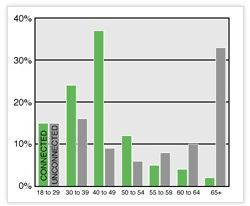Educational institutions may have been some of the first organizations to embrace it by virtue of its origins in defense research and communication, but now everyone from grandmothers to grandchildren is using it every day. What is it that has so many people excited? It’s the Internet, a communications revolution like few that has been experienced in the history of the world. With this technology sweeping the globe, many charitable organizations and institutions have found themselves asking, “What can the Internet do for us?”
Before you spend your endowment on a flashy Web site, or, conversely, veto going online altogether, you may want to consider the results of a survey conducted by Luntz Research Companies for Wired magazine and the Merrill Lynch Forum.
Boomers and young adults vs. 55-plus age group
The Digital Citizen Survey, conducted in September 1997, divided those questioned into different categories depending on their use of computers and online technology. If you send e-mail at least three times a week and use at least three of the following technologies regularly–a cellular phone, a pager, a laptop, and a home computer– you are considered “connected” in this survey. An “unconnected” individual does not use e-mail or any of the listed technologies.
According to the survey results, age is a good indicator of computer and online usage. The survey found that the majority of computer owners and technology advocates are baby boomers and young adults. Of those considered to be “connected,” 73% are between the ages of 30 and 54. Forty-eight percent of “connected” individuals are female so there appears to be little or no “gender gap” in connectivity.
Of interest to gift planners, however, is the fact that Americans, age 55 and older, do not yet appear to be “connected” for the most part. Only 5% of the 55-59 age group are “connected,” and that number drops to 2% (one out of fifty) for those 65 and over.
Are “connected” Americans among your constituency?

With the apparent technological generation gap, development professionals who are considering how to best utilize the Web for their charitable organizations may need to take a fresh look at the age of their donors.
Organizations and institutions with a high percentage of younger donors and baby boomers may find that an online presence would serve them well as a communications and fund-gathering tool. Many educational institutions are already using their Web sites to keep in touch with alumni who are scattered across the country and sometimes around the world.
On the other hand, charitable entities with donor bases consisting of mainly older individuals may not need a great presence online–at least not yet. According to the survey, the older Americans who make up the current “unconnected” category do not expect to own a computer in the near future. Therefore, trying to communicate with this group online is probably not a good idea and where budget is limited, it might be best spent in communications with this group using print, personal visits, and more traditional media. An exception may be older donors who are extremely affluent and/or those who may have recently retired from employment that required them to be “computer literate.” Future research may shed more light on this aspect of the market.
But as the current group of “connected” baby boomers replaces the older generation, we will most likely begin to see an even larger number of computer-savvy people aged 50 and older. And that may mean development professionals will have to rethink the way their organizations use the Internet and other technologies to reach these donors.
Online–in your own time
Boomers are already computer enthusiasts, and they are also going to be the beneficiaries of an estimated $8 trillion to $11 trillion wealth transfer over the next 40 years. With that in mind, gift planners will increasingly need to be aware of the demographic profile of their donors in order to determine just how “tangled” in the Web their organizations should be. Whether an organization simply decides to add e-mail capability or chooses to maintain an elaborate Web site with extensive planned giving information available to the browsers among their constituency, the decision to offer online services to donors should be determined on a case by case basis with an idea to your donors’ preference for communication and information gathering, and how that may be shifting over time.
(For more information, you may review the results of the Digital Citizen Survey on the Wired Web site at www.hotwired.com/special/citizen.)

